Social Media Marketing Plan for CafePod Coffee Company Report
VerifiedAdded on 2023/01/09
|10
|2817
|27
Report
AI Summary
This report presents a comprehensive social media marketing plan for CafePod, an independent coffee company. It begins with an executive summary and introduction, followed by a detailed marketing audit utilizing SWOT and PESTEL analyses to assess CafePod's current market position and external environment. The report identifies the target audience as adventurous coffee drinkers and young consumers seeking affordable, quality coffee. It explores the different zones of social media and recommends strategies for social commerce, focusing on enhancing the online shopping experience and utilizing customer reviews and ratings. An activation plan is outlined, including the development of a new website and increased social media presence across platforms like Instagram, Facebook, Twitter, and YouTube. The plan includes a marketing budget and emphasizes the importance of managing, measuring, and evaluating the plan's effectiveness. The report aims to increase brand awareness and attract a larger customer base.

Entrepreneurial
Marketing
1
Marketing
1
Paraphrase This Document
Need a fresh take? Get an instant paraphrase of this document with our AI Paraphraser
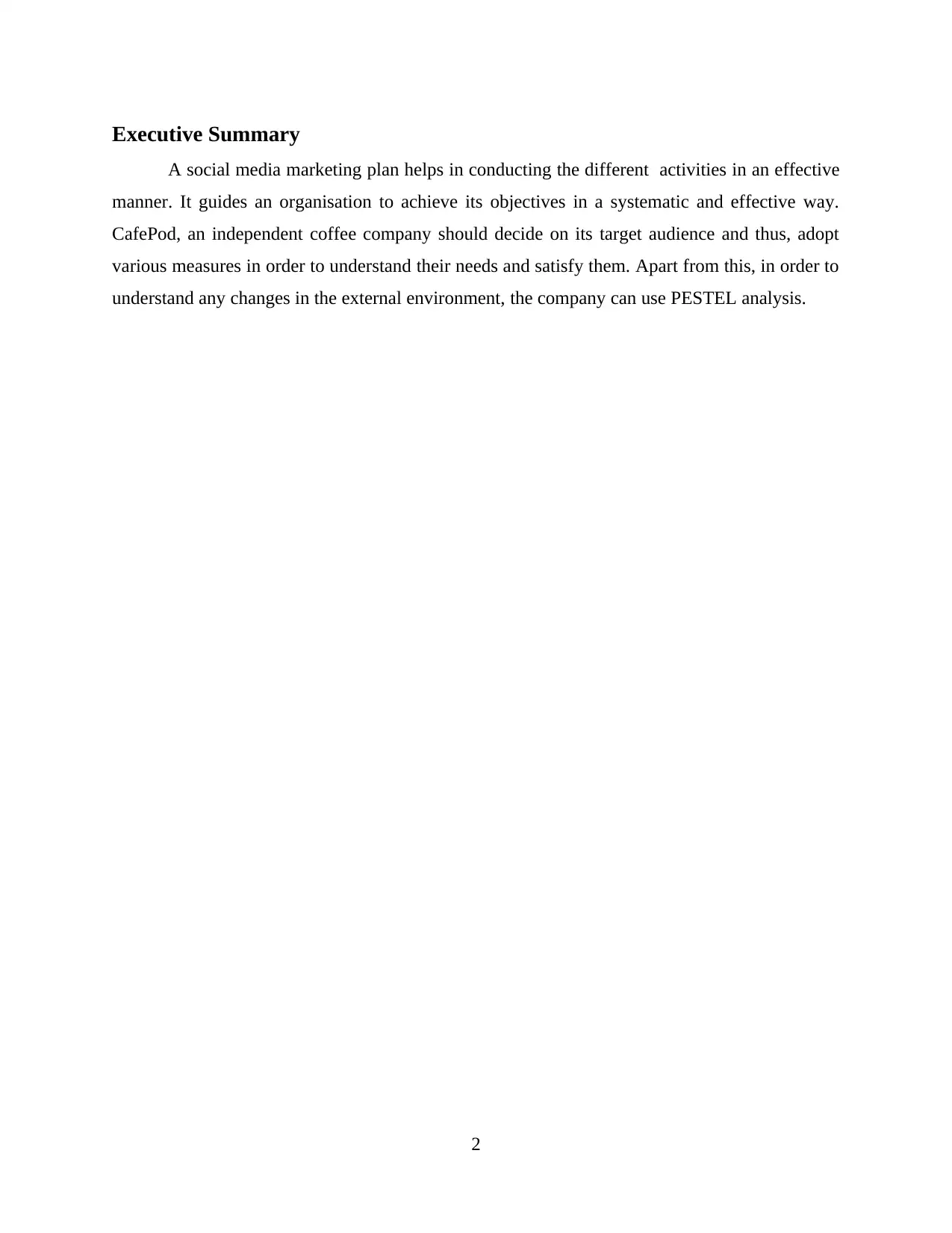
Executive Summary
A social media marketing plan helps in conducting the different activities in an effective
manner. It guides an organisation to achieve its objectives in a systematic and effective way.
CafePod, an independent coffee company should decide on its target audience and thus, adopt
various measures in order to understand their needs and satisfy them. Apart from this, in order to
understand any changes in the external environment, the company can use PESTEL analysis.
2
A social media marketing plan helps in conducting the different activities in an effective
manner. It guides an organisation to achieve its objectives in a systematic and effective way.
CafePod, an independent coffee company should decide on its target audience and thus, adopt
various measures in order to understand their needs and satisfy them. Apart from this, in order to
understand any changes in the external environment, the company can use PESTEL analysis.
2
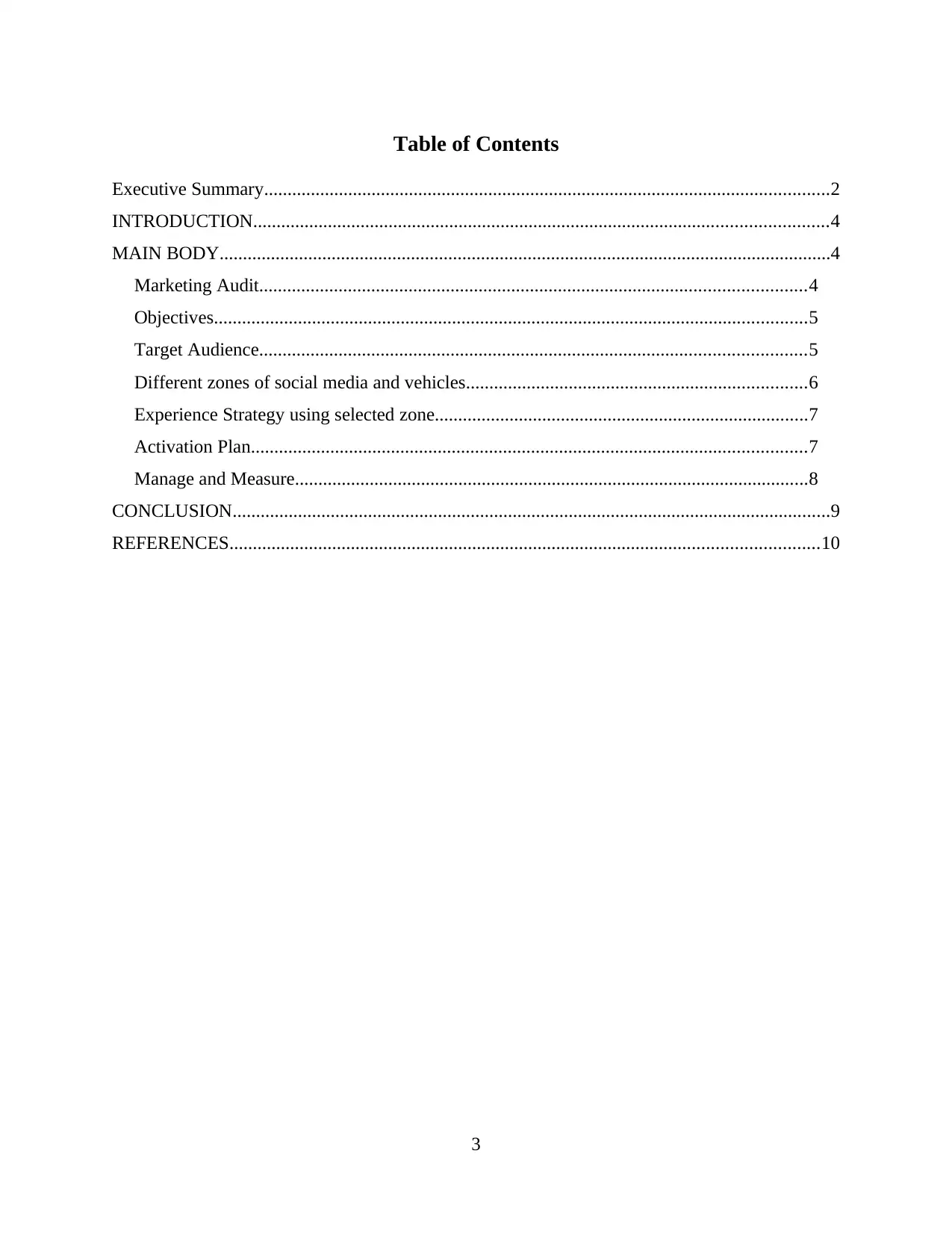
Table of Contents
Executive Summary.........................................................................................................................2
INTRODUCTION...........................................................................................................................4
MAIN BODY...................................................................................................................................4
Marketing Audit.....................................................................................................................4
Objectives...............................................................................................................................5
Target Audience.....................................................................................................................5
Different zones of social media and vehicles.........................................................................6
Experience Strategy using selected zone................................................................................7
Activation Plan.......................................................................................................................7
Manage and Measure..............................................................................................................8
CONCLUSION................................................................................................................................9
REFERENCES..............................................................................................................................10
3
Executive Summary.........................................................................................................................2
INTRODUCTION...........................................................................................................................4
MAIN BODY...................................................................................................................................4
Marketing Audit.....................................................................................................................4
Objectives...............................................................................................................................5
Target Audience.....................................................................................................................5
Different zones of social media and vehicles.........................................................................6
Experience Strategy using selected zone................................................................................7
Activation Plan.......................................................................................................................7
Manage and Measure..............................................................................................................8
CONCLUSION................................................................................................................................9
REFERENCES..............................................................................................................................10
3
⊘ This is a preview!⊘
Do you want full access?
Subscribe today to unlock all pages.

Trusted by 1+ million students worldwide
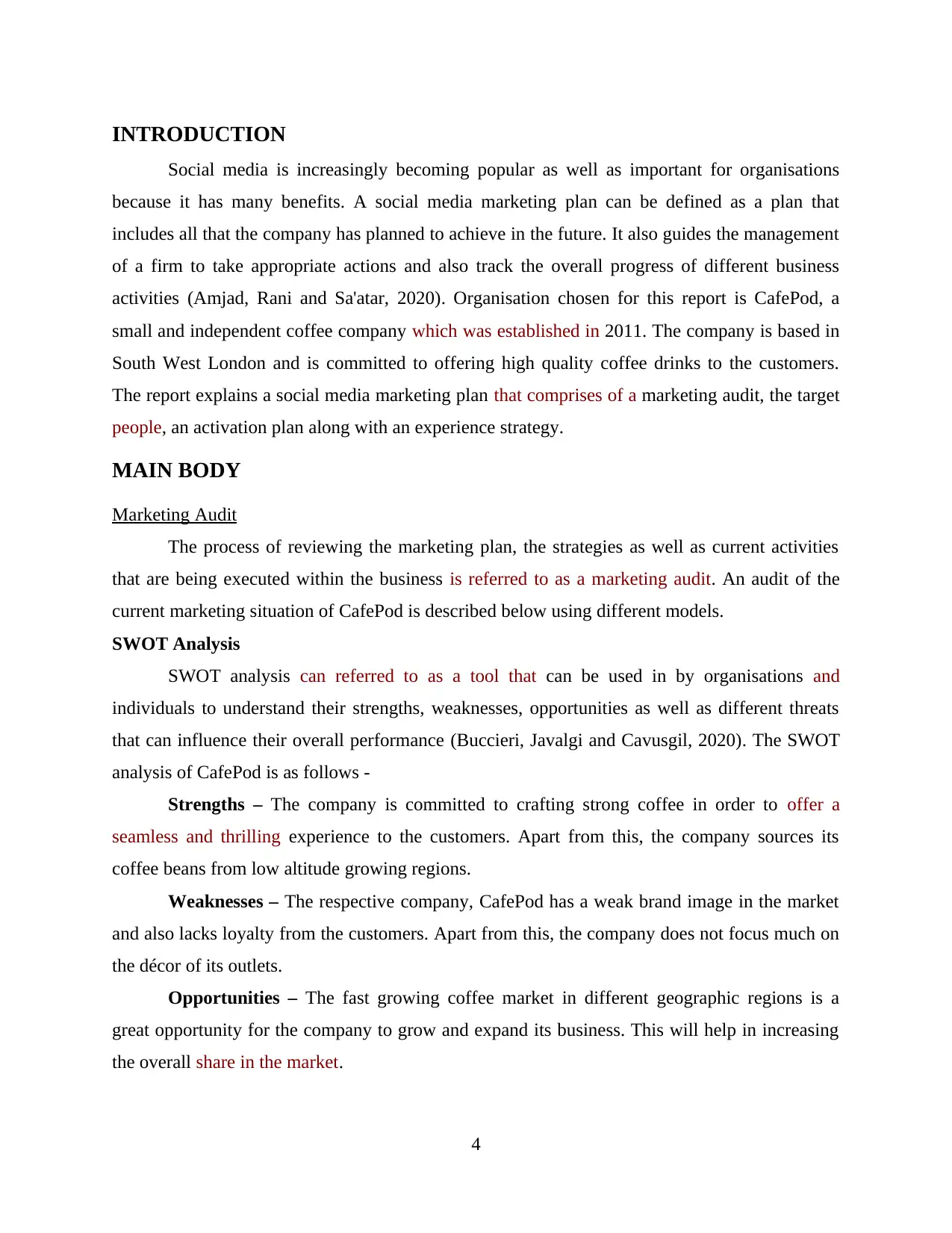
INTRODUCTION
Social media is increasingly becoming popular as well as important for organisations
because it has many benefits. A social media marketing plan can be defined as a plan that
includes all that the company has planned to achieve in the future. It also guides the management
of a firm to take appropriate actions and also track the overall progress of different business
activities (Amjad, Rani and Sa'atar, 2020). Organisation chosen for this report is CafePod, a
small and independent coffee company which was established in 2011. The company is based in
South West London and is committed to offering high quality coffee drinks to the customers.
The report explains a social media marketing plan that comprises of a marketing audit, the target
people, an activation plan along with an experience strategy.
MAIN BODY
Marketing Audit
The process of reviewing the marketing plan, the strategies as well as current activities
that are being executed within the business is referred to as a marketing audit. An audit of the
current marketing situation of CafePod is described below using different models.
SWOT Analysis
SWOT analysis can referred to as a tool that can be used in by organisations and
individuals to understand their strengths, weaknesses, opportunities as well as different threats
that can influence their overall performance (Buccieri, Javalgi and Cavusgil, 2020). The SWOT
analysis of CafePod is as follows -
Strengths – The company is committed to crafting strong coffee in order to offer a
seamless and thrilling experience to the customers. Apart from this, the company sources its
coffee beans from low altitude growing regions.
Weaknesses – The respective company, CafePod has a weak brand image in the market
and also lacks loyalty from the customers. Apart from this, the company does not focus much on
the décor of its outlets.
Opportunities – The fast growing coffee market in different geographic regions is a
great opportunity for the company to grow and expand its business. This will help in increasing
the overall share in the market.
4
Social media is increasingly becoming popular as well as important for organisations
because it has many benefits. A social media marketing plan can be defined as a plan that
includes all that the company has planned to achieve in the future. It also guides the management
of a firm to take appropriate actions and also track the overall progress of different business
activities (Amjad, Rani and Sa'atar, 2020). Organisation chosen for this report is CafePod, a
small and independent coffee company which was established in 2011. The company is based in
South West London and is committed to offering high quality coffee drinks to the customers.
The report explains a social media marketing plan that comprises of a marketing audit, the target
people, an activation plan along with an experience strategy.
MAIN BODY
Marketing Audit
The process of reviewing the marketing plan, the strategies as well as current activities
that are being executed within the business is referred to as a marketing audit. An audit of the
current marketing situation of CafePod is described below using different models.
SWOT Analysis
SWOT analysis can referred to as a tool that can be used in by organisations and
individuals to understand their strengths, weaknesses, opportunities as well as different threats
that can influence their overall performance (Buccieri, Javalgi and Cavusgil, 2020). The SWOT
analysis of CafePod is as follows -
Strengths – The company is committed to crafting strong coffee in order to offer a
seamless and thrilling experience to the customers. Apart from this, the company sources its
coffee beans from low altitude growing regions.
Weaknesses – The respective company, CafePod has a weak brand image in the market
and also lacks loyalty from the customers. Apart from this, the company does not focus much on
the décor of its outlets.
Opportunities – The fast growing coffee market in different geographic regions is a
great opportunity for the company to grow and expand its business. This will help in increasing
the overall share in the market.
4
Paraphrase This Document
Need a fresh take? Get an instant paraphrase of this document with our AI Paraphraser
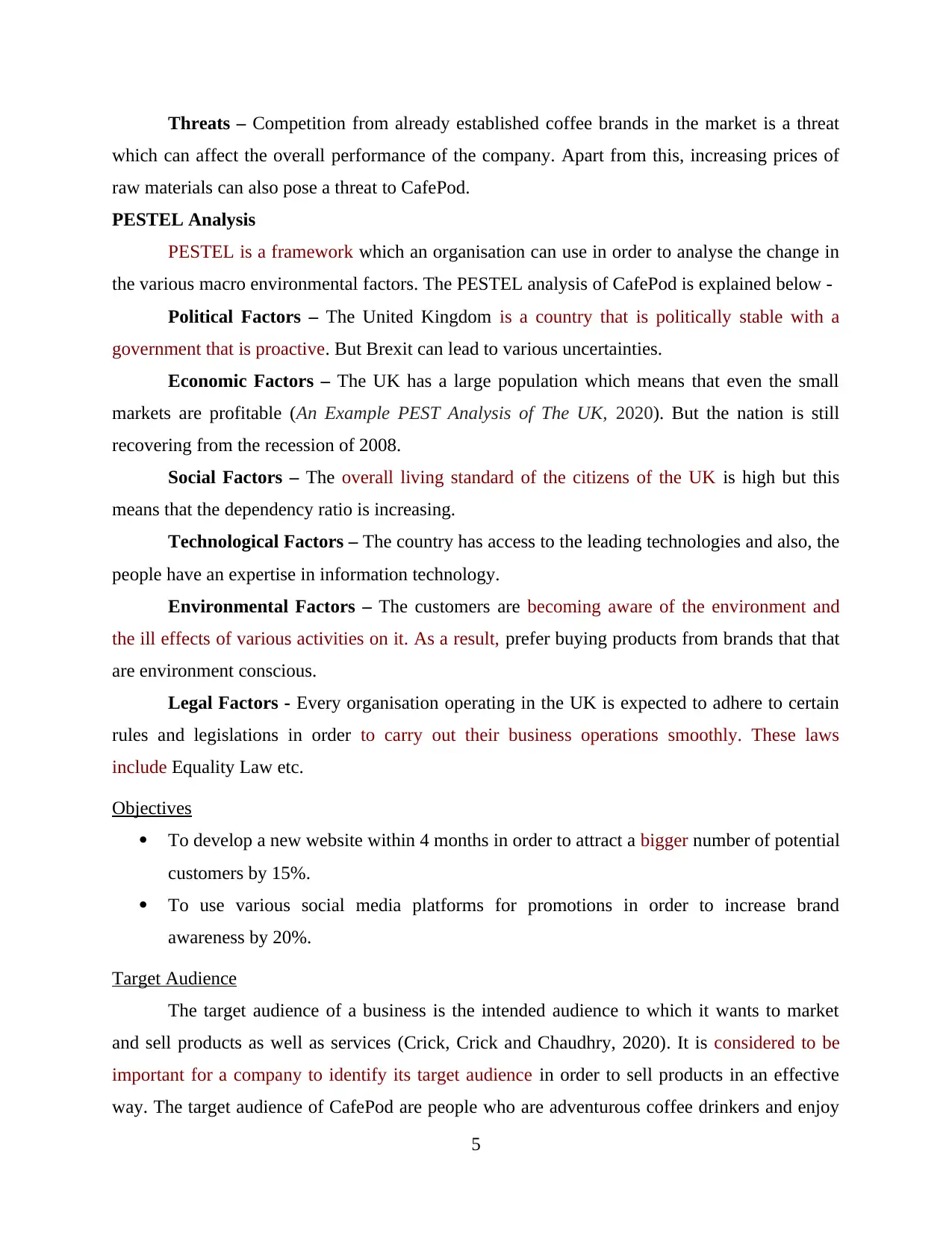
Threats – Competition from already established coffee brands in the market is a threat
which can affect the overall performance of the company. Apart from this, increasing prices of
raw materials can also pose a threat to CafePod.
PESTEL Analysis
PESTEL is a framework which an organisation can use in order to analyse the change in
the various macro environmental factors. The PESTEL analysis of CafePod is explained below -
Political Factors – The United Kingdom is a country that is politically stable with a
government that is proactive. But Brexit can lead to various uncertainties.
Economic Factors – The UK has a large population which means that even the small
markets are profitable (An Example PEST Analysis of The UK, 2020). But the nation is still
recovering from the recession of 2008.
Social Factors – The overall living standard of the citizens of the UK is high but this
means that the dependency ratio is increasing.
Technological Factors – The country has access to the leading technologies and also, the
people have an expertise in information technology.
Environmental Factors – The customers are becoming aware of the environment and
the ill effects of various activities on it. As a result, prefer buying products from brands that that
are environment conscious.
Legal Factors - Every organisation operating in the UK is expected to adhere to certain
rules and legislations in order to carry out their business operations smoothly. These laws
include Equality Law etc.
Objectives
To develop a new website within 4 months in order to attract a bigger number of potential
customers by 15%.
To use various social media platforms for promotions in order to increase brand
awareness by 20%.
Target Audience
The target audience of a business is the intended audience to which it wants to market
and sell products as well as services (Crick, Crick and Chaudhry, 2020). It is considered to be
important for a company to identify its target audience in order to sell products in an effective
way. The target audience of CafePod are people who are adventurous coffee drinkers and enjoy
5
which can affect the overall performance of the company. Apart from this, increasing prices of
raw materials can also pose a threat to CafePod.
PESTEL Analysis
PESTEL is a framework which an organisation can use in order to analyse the change in
the various macro environmental factors. The PESTEL analysis of CafePod is explained below -
Political Factors – The United Kingdom is a country that is politically stable with a
government that is proactive. But Brexit can lead to various uncertainties.
Economic Factors – The UK has a large population which means that even the small
markets are profitable (An Example PEST Analysis of The UK, 2020). But the nation is still
recovering from the recession of 2008.
Social Factors – The overall living standard of the citizens of the UK is high but this
means that the dependency ratio is increasing.
Technological Factors – The country has access to the leading technologies and also, the
people have an expertise in information technology.
Environmental Factors – The customers are becoming aware of the environment and
the ill effects of various activities on it. As a result, prefer buying products from brands that that
are environment conscious.
Legal Factors - Every organisation operating in the UK is expected to adhere to certain
rules and legislations in order to carry out their business operations smoothly. These laws
include Equality Law etc.
Objectives
To develop a new website within 4 months in order to attract a bigger number of potential
customers by 15%.
To use various social media platforms for promotions in order to increase brand
awareness by 20%.
Target Audience
The target audience of a business is the intended audience to which it wants to market
and sell products as well as services (Crick, Crick and Chaudhry, 2020). It is considered to be
important for a company to identify its target audience in order to sell products in an effective
way. The target audience of CafePod are people who are adventurous coffee drinkers and enjoy
5
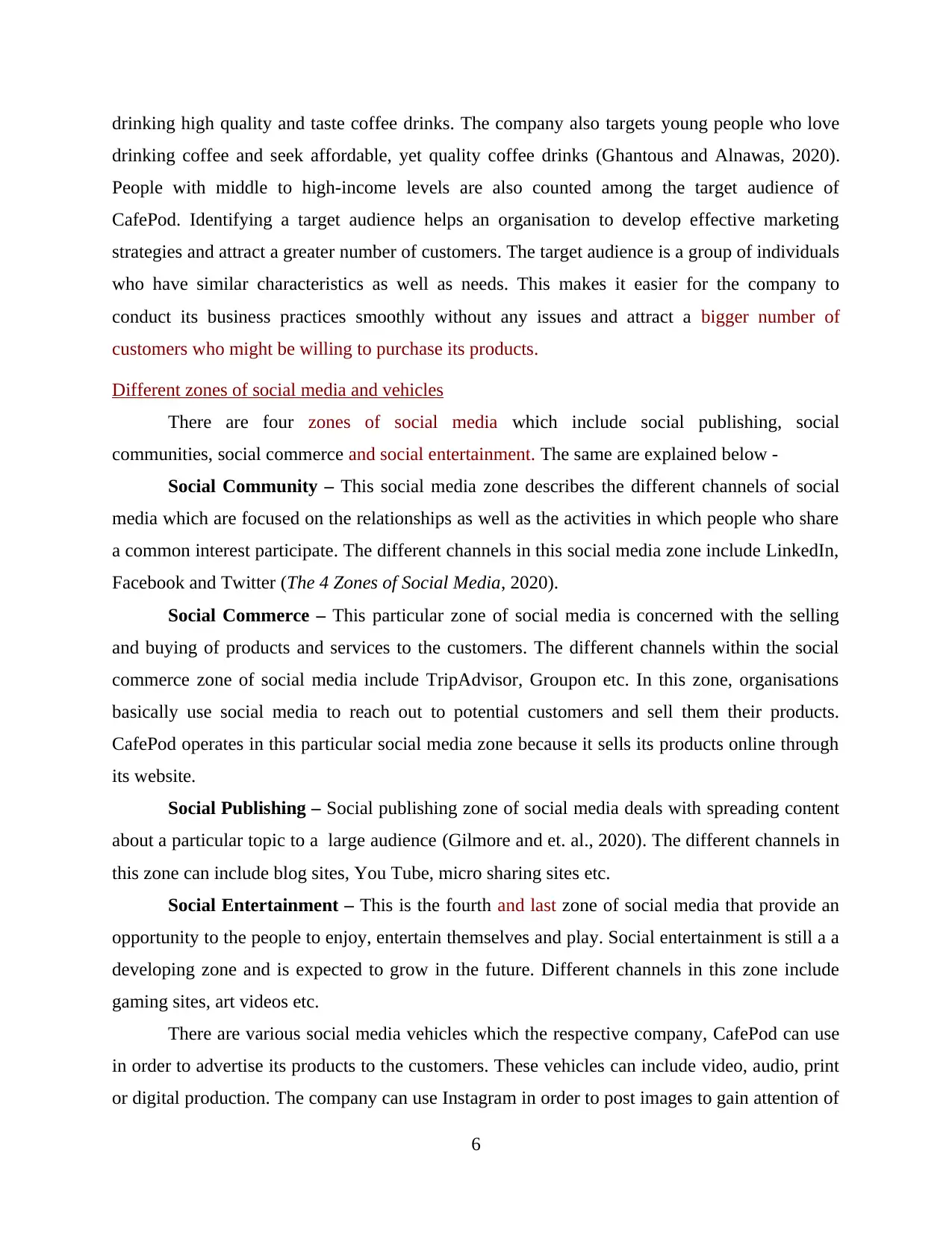
drinking high quality and taste coffee drinks. The company also targets young people who love
drinking coffee and seek affordable, yet quality coffee drinks (Ghantous and Alnawas, 2020).
People with middle to high-income levels are also counted among the target audience of
CafePod. Identifying a target audience helps an organisation to develop effective marketing
strategies and attract a greater number of customers. The target audience is a group of individuals
who have similar characteristics as well as needs. This makes it easier for the company to
conduct its business practices smoothly without any issues and attract a bigger number of
customers who might be willing to purchase its products.
Different zones of social media and vehicles
There are four zones of social media which include social publishing, social
communities, social commerce and social entertainment. The same are explained below -
Social Community – This social media zone describes the different channels of social
media which are focused on the relationships as well as the activities in which people who share
a common interest participate. The different channels in this social media zone include LinkedIn,
Facebook and Twitter (The 4 Zones of Social Media, 2020).
Social Commerce – This particular zone of social media is concerned with the selling
and buying of products and services to the customers. The different channels within the social
commerce zone of social media include TripAdvisor, Groupon etc. In this zone, organisations
basically use social media to reach out to potential customers and sell them their products.
CafePod operates in this particular social media zone because it sells its products online through
its website.
Social Publishing – Social publishing zone of social media deals with spreading content
about a particular topic to a large audience (Gilmore and et. al., 2020). The different channels in
this zone can include blog sites, You Tube, micro sharing sites etc.
Social Entertainment – This is the fourth and last zone of social media that provide an
opportunity to the people to enjoy, entertain themselves and play. Social entertainment is still a a
developing zone and is expected to grow in the future. Different channels in this zone include
gaming sites, art videos etc.
There are various social media vehicles which the respective company, CafePod can use
in order to advertise its products to the customers. These vehicles can include video, audio, print
or digital production. The company can use Instagram in order to post images to gain attention of
6
drinking coffee and seek affordable, yet quality coffee drinks (Ghantous and Alnawas, 2020).
People with middle to high-income levels are also counted among the target audience of
CafePod. Identifying a target audience helps an organisation to develop effective marketing
strategies and attract a greater number of customers. The target audience is a group of individuals
who have similar characteristics as well as needs. This makes it easier for the company to
conduct its business practices smoothly without any issues and attract a bigger number of
customers who might be willing to purchase its products.
Different zones of social media and vehicles
There are four zones of social media which include social publishing, social
communities, social commerce and social entertainment. The same are explained below -
Social Community – This social media zone describes the different channels of social
media which are focused on the relationships as well as the activities in which people who share
a common interest participate. The different channels in this social media zone include LinkedIn,
Facebook and Twitter (The 4 Zones of Social Media, 2020).
Social Commerce – This particular zone of social media is concerned with the selling
and buying of products and services to the customers. The different channels within the social
commerce zone of social media include TripAdvisor, Groupon etc. In this zone, organisations
basically use social media to reach out to potential customers and sell them their products.
CafePod operates in this particular social media zone because it sells its products online through
its website.
Social Publishing – Social publishing zone of social media deals with spreading content
about a particular topic to a large audience (Gilmore and et. al., 2020). The different channels in
this zone can include blog sites, You Tube, micro sharing sites etc.
Social Entertainment – This is the fourth and last zone of social media that provide an
opportunity to the people to enjoy, entertain themselves and play. Social entertainment is still a a
developing zone and is expected to grow in the future. Different channels in this zone include
gaming sites, art videos etc.
There are various social media vehicles which the respective company, CafePod can use
in order to advertise its products to the customers. These vehicles can include video, audio, print
or digital production. The company can use Instagram in order to post images to gain attention of
6
⊘ This is a preview!⊘
Do you want full access?
Subscribe today to unlock all pages.

Trusted by 1+ million students worldwide
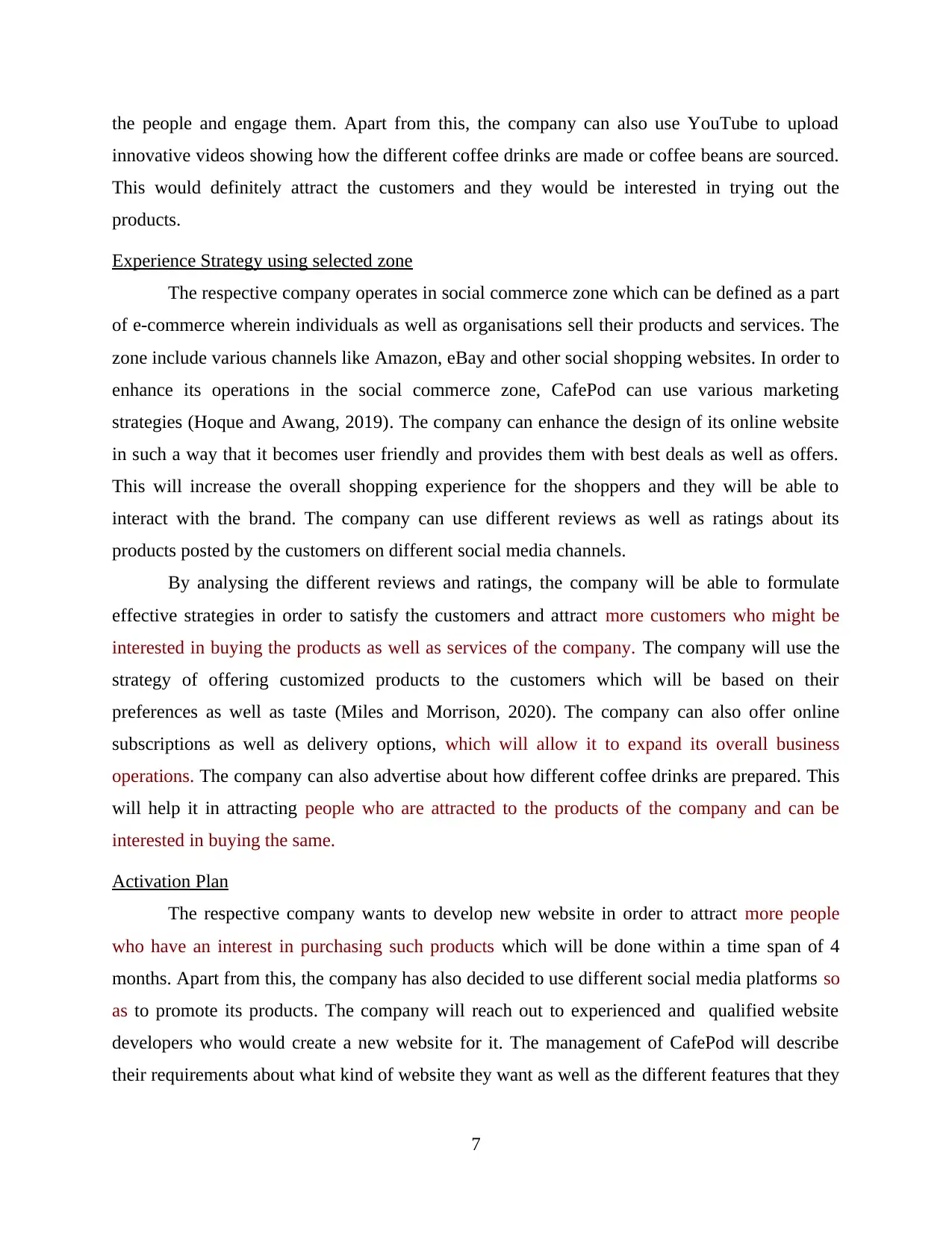
the people and engage them. Apart from this, the company can also use YouTube to upload
innovative videos showing how the different coffee drinks are made or coffee beans are sourced.
This would definitely attract the customers and they would be interested in trying out the
products.
Experience Strategy using selected zone
The respective company operates in social commerce zone which can be defined as a part
of e-commerce wherein individuals as well as organisations sell their products and services. The
zone include various channels like Amazon, eBay and other social shopping websites. In order to
enhance its operations in the social commerce zone, CafePod can use various marketing
strategies (Hoque and Awang, 2019). The company can enhance the design of its online website
in such a way that it becomes user friendly and provides them with best deals as well as offers.
This will increase the overall shopping experience for the shoppers and they will be able to
interact with the brand. The company can use different reviews as well as ratings about its
products posted by the customers on different social media channels.
By analysing the different reviews and ratings, the company will be able to formulate
effective strategies in order to satisfy the customers and attract more customers who might be
interested in buying the products as well as services of the company. The company will use the
strategy of offering customized products to the customers which will be based on their
preferences as well as taste (Miles and Morrison, 2020). The company can also offer online
subscriptions as well as delivery options, which will allow it to expand its overall business
operations. The company can also advertise about how different coffee drinks are prepared. This
will help it in attracting people who are attracted to the products of the company and can be
interested in buying the same.
Activation Plan
The respective company wants to develop new website in order to attract more people
who have an interest in purchasing such products which will be done within a time span of 4
months. Apart from this, the company has also decided to use different social media platforms so
as to promote its products. The company will reach out to experienced and qualified website
developers who would create a new website for it. The management of CafePod will describe
their requirements about what kind of website they want as well as the different features that they
7
innovative videos showing how the different coffee drinks are made or coffee beans are sourced.
This would definitely attract the customers and they would be interested in trying out the
products.
Experience Strategy using selected zone
The respective company operates in social commerce zone which can be defined as a part
of e-commerce wherein individuals as well as organisations sell their products and services. The
zone include various channels like Amazon, eBay and other social shopping websites. In order to
enhance its operations in the social commerce zone, CafePod can use various marketing
strategies (Hoque and Awang, 2019). The company can enhance the design of its online website
in such a way that it becomes user friendly and provides them with best deals as well as offers.
This will increase the overall shopping experience for the shoppers and they will be able to
interact with the brand. The company can use different reviews as well as ratings about its
products posted by the customers on different social media channels.
By analysing the different reviews and ratings, the company will be able to formulate
effective strategies in order to satisfy the customers and attract more customers who might be
interested in buying the products as well as services of the company. The company will use the
strategy of offering customized products to the customers which will be based on their
preferences as well as taste (Miles and Morrison, 2020). The company can also offer online
subscriptions as well as delivery options, which will allow it to expand its overall business
operations. The company can also advertise about how different coffee drinks are prepared. This
will help it in attracting people who are attracted to the products of the company and can be
interested in buying the same.
Activation Plan
The respective company wants to develop new website in order to attract more people
who have an interest in purchasing such products which will be done within a time span of 4
months. Apart from this, the company has also decided to use different social media platforms so
as to promote its products. The company will reach out to experienced and qualified website
developers who would create a new website for it. The management of CafePod will describe
their requirements about what kind of website they want as well as the different features that they
7
Paraphrase This Document
Need a fresh take? Get an instant paraphrase of this document with our AI Paraphraser
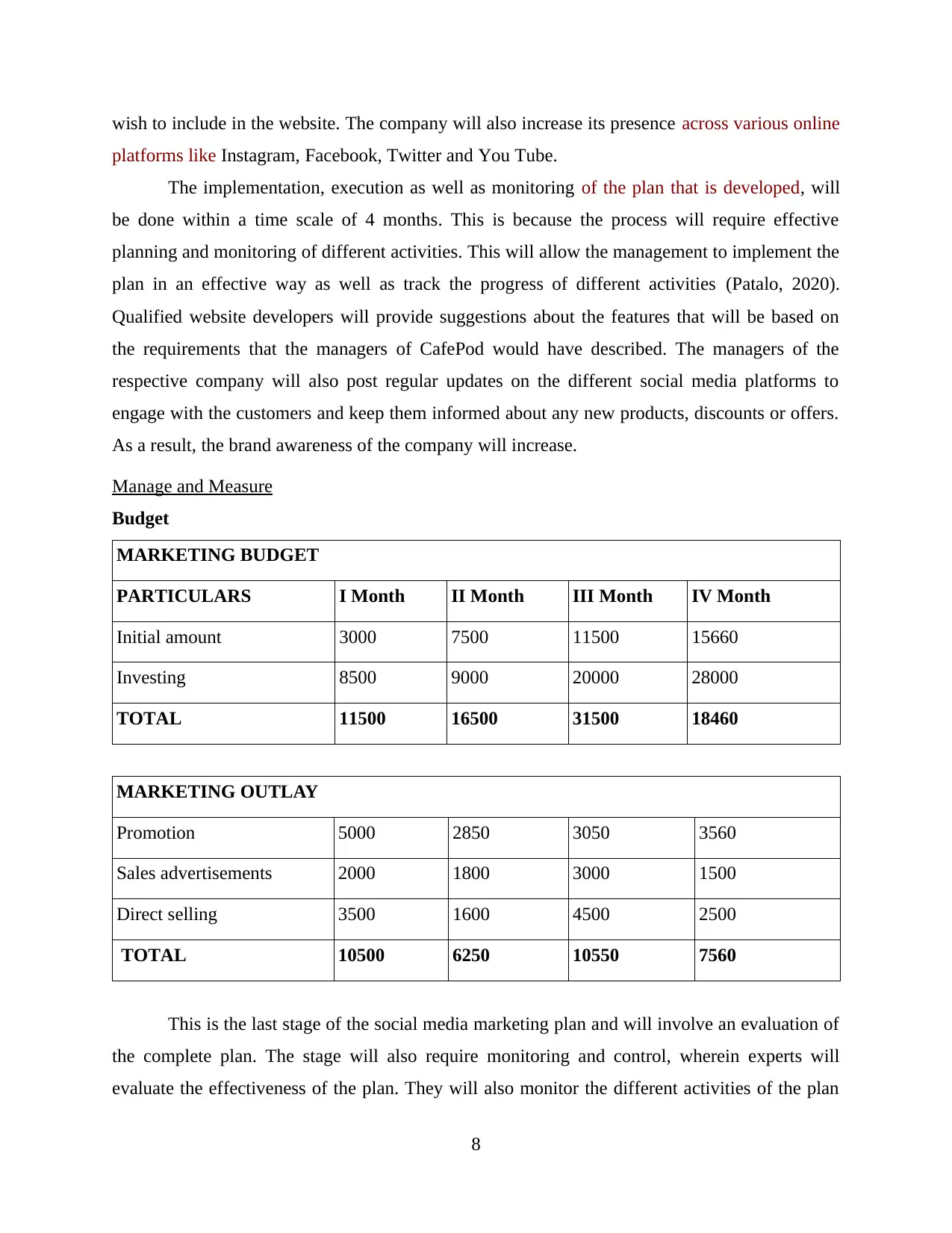
wish to include in the website. The company will also increase its presence across various online
platforms like Instagram, Facebook, Twitter and You Tube.
The implementation, execution as well as monitoring of the plan that is developed, will
be done within a time scale of 4 months. This is because the process will require effective
planning and monitoring of different activities. This will allow the management to implement the
plan in an effective way as well as track the progress of different activities (Patalo, 2020).
Qualified website developers will provide suggestions about the features that will be based on
the requirements that the managers of CafePod would have described. The managers of the
respective company will also post regular updates on the different social media platforms to
engage with the customers and keep them informed about any new products, discounts or offers.
As a result, the brand awareness of the company will increase.
Manage and Measure
Budget
MARKETING BUDGET
PARTICULARS I Month II Month III Month IV Month
Initial amount 3000 7500 11500 15660
Investing 8500 9000 20000 28000
TOTAL 11500 16500 31500 18460
MARKETING OUTLAY
Promotion 5000 2850 3050 3560
Sales advertisements 2000 1800 3000 1500
Direct selling 3500 1600 4500 2500
TOTAL 10500 6250 10550 7560
This is the last stage of the social media marketing plan and will involve an evaluation of
the complete plan. The stage will also require monitoring and control, wherein experts will
evaluate the effectiveness of the plan. They will also monitor the different activities of the plan
8
platforms like Instagram, Facebook, Twitter and You Tube.
The implementation, execution as well as monitoring of the plan that is developed, will
be done within a time scale of 4 months. This is because the process will require effective
planning and monitoring of different activities. This will allow the management to implement the
plan in an effective way as well as track the progress of different activities (Patalo, 2020).
Qualified website developers will provide suggestions about the features that will be based on
the requirements that the managers of CafePod would have described. The managers of the
respective company will also post regular updates on the different social media platforms to
engage with the customers and keep them informed about any new products, discounts or offers.
As a result, the brand awareness of the company will increase.
Manage and Measure
Budget
MARKETING BUDGET
PARTICULARS I Month II Month III Month IV Month
Initial amount 3000 7500 11500 15660
Investing 8500 9000 20000 28000
TOTAL 11500 16500 31500 18460
MARKETING OUTLAY
Promotion 5000 2850 3050 3560
Sales advertisements 2000 1800 3000 1500
Direct selling 3500 1600 4500 2500
TOTAL 10500 6250 10550 7560
This is the last stage of the social media marketing plan and will involve an evaluation of
the complete plan. The stage will also require monitoring and control, wherein experts will
evaluate the effectiveness of the plan. They will also monitor the different activities of the plan
8
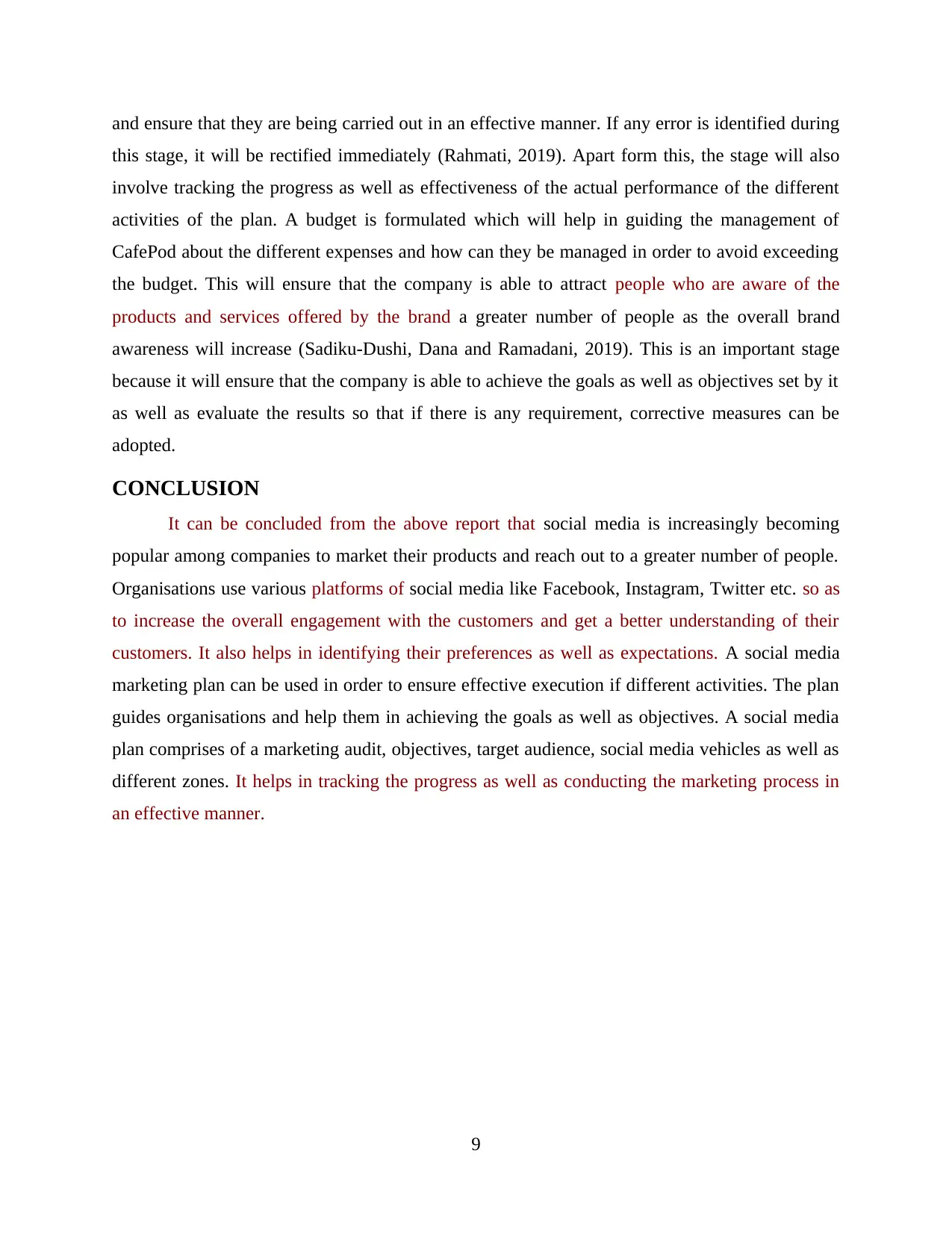
and ensure that they are being carried out in an effective manner. If any error is identified during
this stage, it will be rectified immediately (Rahmati, 2019). Apart form this, the stage will also
involve tracking the progress as well as effectiveness of the actual performance of the different
activities of the plan. A budget is formulated which will help in guiding the management of
CafePod about the different expenses and how can they be managed in order to avoid exceeding
the budget. This will ensure that the company is able to attract people who are aware of the
products and services offered by the brand a greater number of people as the overall brand
awareness will increase (Sadiku-Dushi, Dana and Ramadani, 2019). This is an important stage
because it will ensure that the company is able to achieve the goals as well as objectives set by it
as well as evaluate the results so that if there is any requirement, corrective measures can be
adopted.
CONCLUSION
It can be concluded from the above report that social media is increasingly becoming
popular among companies to market their products and reach out to a greater number of people.
Organisations use various platforms of social media like Facebook, Instagram, Twitter etc. so as
to increase the overall engagement with the customers and get a better understanding of their
customers. It also helps in identifying their preferences as well as expectations. A social media
marketing plan can be used in order to ensure effective execution if different activities. The plan
guides organisations and help them in achieving the goals as well as objectives. A social media
plan comprises of a marketing audit, objectives, target audience, social media vehicles as well as
different zones. It helps in tracking the progress as well as conducting the marketing process in
an effective manner.
9
this stage, it will be rectified immediately (Rahmati, 2019). Apart form this, the stage will also
involve tracking the progress as well as effectiveness of the actual performance of the different
activities of the plan. A budget is formulated which will help in guiding the management of
CafePod about the different expenses and how can they be managed in order to avoid exceeding
the budget. This will ensure that the company is able to attract people who are aware of the
products and services offered by the brand a greater number of people as the overall brand
awareness will increase (Sadiku-Dushi, Dana and Ramadani, 2019). This is an important stage
because it will ensure that the company is able to achieve the goals as well as objectives set by it
as well as evaluate the results so that if there is any requirement, corrective measures can be
adopted.
CONCLUSION
It can be concluded from the above report that social media is increasingly becoming
popular among companies to market their products and reach out to a greater number of people.
Organisations use various platforms of social media like Facebook, Instagram, Twitter etc. so as
to increase the overall engagement with the customers and get a better understanding of their
customers. It also helps in identifying their preferences as well as expectations. A social media
marketing plan can be used in order to ensure effective execution if different activities. The plan
guides organisations and help them in achieving the goals as well as objectives. A social media
plan comprises of a marketing audit, objectives, target audience, social media vehicles as well as
different zones. It helps in tracking the progress as well as conducting the marketing process in
an effective manner.
9
⊘ This is a preview!⊘
Do you want full access?
Subscribe today to unlock all pages.

Trusted by 1+ million students worldwide
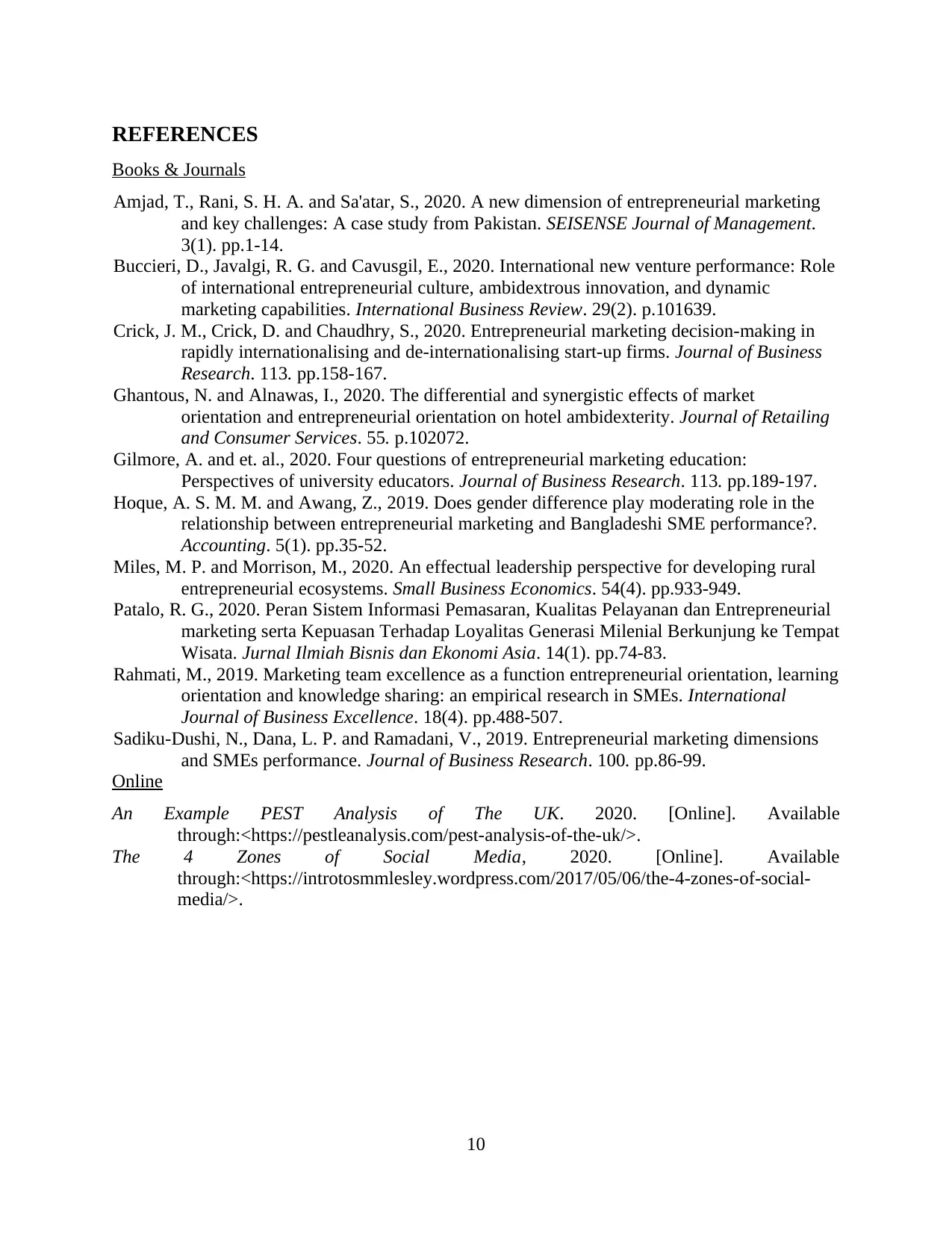
REFERENCES
Books & Journals
Amjad, T., Rani, S. H. A. and Sa'atar, S., 2020. A new dimension of entrepreneurial marketing
and key challenges: A case study from Pakistan. SEISENSE Journal of Management.
3(1). pp.1-14.
Buccieri, D., Javalgi, R. G. and Cavusgil, E., 2020. International new venture performance: Role
of international entrepreneurial culture, ambidextrous innovation, and dynamic
marketing capabilities. International Business Review. 29(2). p.101639.
Crick, J. M., Crick, D. and Chaudhry, S., 2020. Entrepreneurial marketing decision-making in
rapidly internationalising and de-internationalising start-up firms. Journal of Business
Research. 113. pp.158-167.
Ghantous, N. and Alnawas, I., 2020. The differential and synergistic effects of market
orientation and entrepreneurial orientation on hotel ambidexterity. Journal of Retailing
and Consumer Services. 55. p.102072.
Gilmore, A. and et. al., 2020. Four questions of entrepreneurial marketing education:
Perspectives of university educators. Journal of Business Research. 113. pp.189-197.
Hoque, A. S. M. M. and Awang, Z., 2019. Does gender difference play moderating role in the
relationship between entrepreneurial marketing and Bangladeshi SME performance?.
Accounting. 5(1). pp.35-52.
Miles, M. P. and Morrison, M., 2020. An effectual leadership perspective for developing rural
entrepreneurial ecosystems. Small Business Economics. 54(4). pp.933-949.
Patalo, R. G., 2020. Peran Sistem Informasi Pemasaran, Kualitas Pelayanan dan Entrepreneurial
marketing serta Kepuasan Terhadap Loyalitas Generasi Milenial Berkunjung ke Tempat
Wisata. Jurnal Ilmiah Bisnis dan Ekonomi Asia. 14(1). pp.74-83.
Rahmati, M., 2019. Marketing team excellence as a function entrepreneurial orientation, learning
orientation and knowledge sharing: an empirical research in SMEs. International
Journal of Business Excellence. 18(4). pp.488-507.
Sadiku-Dushi, N., Dana, L. P. and Ramadani, V., 2019. Entrepreneurial marketing dimensions
and SMEs performance. Journal of Business Research. 100. pp.86-99.
Online
An Example PEST Analysis of The UK. 2020. [Online]. Available
through:<https://pestleanalysis.com/pest-analysis-of-the-uk/>.
The 4 Zones of Social Media, 2020. [Online]. Available
through:<https://introtosmmlesley.wordpress.com/2017/05/06/the-4-zones-of-social-
media/>.
10
Books & Journals
Amjad, T., Rani, S. H. A. and Sa'atar, S., 2020. A new dimension of entrepreneurial marketing
and key challenges: A case study from Pakistan. SEISENSE Journal of Management.
3(1). pp.1-14.
Buccieri, D., Javalgi, R. G. and Cavusgil, E., 2020. International new venture performance: Role
of international entrepreneurial culture, ambidextrous innovation, and dynamic
marketing capabilities. International Business Review. 29(2). p.101639.
Crick, J. M., Crick, D. and Chaudhry, S., 2020. Entrepreneurial marketing decision-making in
rapidly internationalising and de-internationalising start-up firms. Journal of Business
Research. 113. pp.158-167.
Ghantous, N. and Alnawas, I., 2020. The differential and synergistic effects of market
orientation and entrepreneurial orientation on hotel ambidexterity. Journal of Retailing
and Consumer Services. 55. p.102072.
Gilmore, A. and et. al., 2020. Four questions of entrepreneurial marketing education:
Perspectives of university educators. Journal of Business Research. 113. pp.189-197.
Hoque, A. S. M. M. and Awang, Z., 2019. Does gender difference play moderating role in the
relationship between entrepreneurial marketing and Bangladeshi SME performance?.
Accounting. 5(1). pp.35-52.
Miles, M. P. and Morrison, M., 2020. An effectual leadership perspective for developing rural
entrepreneurial ecosystems. Small Business Economics. 54(4). pp.933-949.
Patalo, R. G., 2020. Peran Sistem Informasi Pemasaran, Kualitas Pelayanan dan Entrepreneurial
marketing serta Kepuasan Terhadap Loyalitas Generasi Milenial Berkunjung ke Tempat
Wisata. Jurnal Ilmiah Bisnis dan Ekonomi Asia. 14(1). pp.74-83.
Rahmati, M., 2019. Marketing team excellence as a function entrepreneurial orientation, learning
orientation and knowledge sharing: an empirical research in SMEs. International
Journal of Business Excellence. 18(4). pp.488-507.
Sadiku-Dushi, N., Dana, L. P. and Ramadani, V., 2019. Entrepreneurial marketing dimensions
and SMEs performance. Journal of Business Research. 100. pp.86-99.
Online
An Example PEST Analysis of The UK. 2020. [Online]. Available
through:<https://pestleanalysis.com/pest-analysis-of-the-uk/>.
The 4 Zones of Social Media, 2020. [Online]. Available
through:<https://introtosmmlesley.wordpress.com/2017/05/06/the-4-zones-of-social-
media/>.
10
1 out of 10
Related Documents
Your All-in-One AI-Powered Toolkit for Academic Success.
+13062052269
info@desklib.com
Available 24*7 on WhatsApp / Email
![[object Object]](/_next/static/media/star-bottom.7253800d.svg)
Unlock your academic potential
Copyright © 2020–2025 A2Z Services. All Rights Reserved. Developed and managed by ZUCOL.



